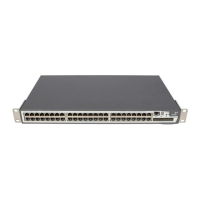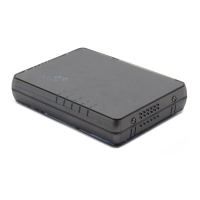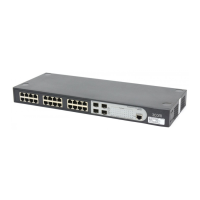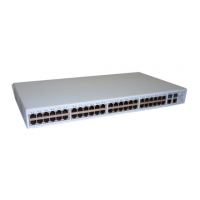1-6
Table 1-2 Packet processing of a trunk port
Processing of an incoming packet
For an untagged packet For a tagged packet
Processing of an outgoing
packet
z If the port has already
been added to its default
VLAN, tag the packet with
the default VLAN tag and
then forward the packet.
z If the port has not been
added to its default VLAN,
discard the packet.
z If the VLAN ID is one of the
VLAN IDs allowed to pass
through the port, receive the
packet.
z If the VLAN ID is not one of
the VLAN IDs allowed to
pass through the port,
discard the packet.
z If the VLAN ID is just the
default VLAN ID, strip off the
tag and send the packet.
z If the VLAN ID is not the
default VLAN ID, keep the
original tag unchanged and
send the packet.
Table 1-3 Packet processing of a hybrid port
Processing of an incoming packet
For an untagged packet For a tagged packet
Processing of an outgoing
packet
z If the port has already
been added to its default
VLAN, tag the packet with
the default VLAN tag and
then forward the packet.
z If the port has not been
added to its default VLAN,
discard the packet.
z If the VLAN ID is one of the
VLAN IDs allowed to pass
through the port, receive the
packet.
z If the VLAN ID is not one of
the VLAN IDs allowed to
pass through the port,
discard the packet.
Send the packet if the VLAN ID
is allowed to pass through the
port. Use the port hybrid vlan
command to configure whether
the port keeps or strips off the
tags when sending packets of a
VLAN (including the default
VLAN).
Protocol-Based VLAN
Introduction to Protocol-Based VLAN
Protocol-based VLAN is also known as protocol VLAN, which is another way to classify VLANs.
Through the protocol-based VLANs, the switch can analyze the received packets carrying no VLAN tag
on the port and match the packets with the user-defined protocol template automatically according to
different encapsulation formats and the values of specific fields. If a packet is matched, the switch will
add a corresponding VLAN tag to it automatically. Thus, data of specific protocol is assigned
automatically to the corresponding VLAN for transmission.
This feature is used for binding the ToS provided in the network to VLAN to facilitate management and
maintenance.
Encapsulation Format of Ethernet Data
This section introduces the common encapsulation formats of Ethernet data for you to understand well
the procedure for the switch to identify the packet protocols.

